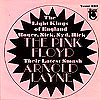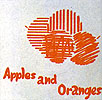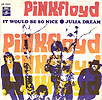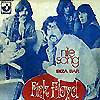

Following the chart success of Atom Heart Mother, EMI's budget subsidiary Starline released a compilation of early singles, album tracks and otherwise unreleased music called Relics, A Bizarre Collection of Antiques and Curios.
The original U.K. cover design was a pen and ink
sketch by Nick Mason. The U.S. album cover, an antique
looking 4-eyed bottle opener, was designed by David Coleman.
The remastered LP was delicately shaded in pink.
The Australian cover consisted of rare coins. And the CD version
has a model ship made by Model Solutions, of Nick Mason's
original design.

EMI Australia briefly released Relics on CD. This occurred without the bands consent and was rapidly withdrawn.
The Japanese version of Relics contained a gatefold sleeve of Nick Mason's drawing.
A unique collectors item of the 4 eyed bottle openers found on the
US version of the Relics album cover is highly prized by Floydians around
the world.

Not counting A Nice Pair (which still does not exist as such), Relics was the last of the official Pink Floyd albums to make it to Compact Disc format.
The songs on Relics, spanned over Pink Floyd's first 3 albums and their earlier singles.
Depending upon where in the world you had purchased your LP
of Piper At The Gates Of Dawn you would get either See Emily Play or
Bike on the album. With the release of Relics both of these songs
would now be available, for the first time to fans, on one LP.




| Arnold Layne was originally recorded at the Whitehead demo sessions in January 1967. A month later it was re-recorded at Sound Techniques with producer Joe Boyd. Arnold Layne (along with Candy and a Currant Bun) was broadcast from a live session at BBC Playhouse, London, April 1967. As the bands first single, Arnold Layne reached #28 on the UK charts. |  |









| See Emily Play was recorded at the same time as the Piper At The Gates Of Dawn album. An early version of the song was called Games For May. See Emily Play was promoted with three appearances on Top Of The Pops. Later all three master tapes were erased by the BBC in the 1980's when the storage space was needed for other programs. A visitor to the recording sessions was Barrett's old friend from Cambridge, David Gilmour, who would later replace Barrett in the band. |  |




| Remember A Day was written by Richard Wright, it is reminiscent of the simplicity of childhood. Originally recorded for the Piper At The Gates Of Dawn album, with Syd Barrett on the guitar, the recording was later finished after Syd's departure and was released on A Saucerful of Secrets album. There is no known live performance of this song. |


| Paintbox debuted as a single on the B-side of the Apples and Oranges Single. Paintbox was an early commentary on the music business - a theme which Pink Floyd would soon come back to in Cymbaline and years later on the Wish You Were Here Album album. |  |


| Julia Dream, Pink Floyd's fourth single, had a working title of Doreen's Dream. This song was the first Pink Floyd arrangement to be recorded with David Gilmour on guitar and the first to feature his vocals. Julia Dream was recorded at Piccadilly Studios, and first broadcast in August 1968. | 
|





| Cirrus Minor, taken from the More soundtrack, was named after a type of cloud formation. This song opens with a library recording of bird song, descriptively labelled Dawns Chorus. Followed by Rick Wright's over-dubbed Hammond and Fafisa organ tracks and a few gentle vocal lines by David Gilmour. A recording of this song was featured in a BBC Radio Three documentary Laying Down Tracks. |


| The Nile Song penned by Roger Waters for the More soundtrack, was Pink Floyd's debut into the realm of heavy metal which featured David Gilmour shouted vocals. Its strength impressed sufficiently to warrant a release as a single in Europe (but not the UK) Japan and New Zealand. |  |




| Bike was written by Syd Barrett for his girlfriend at the time, Jenny Spires. There has been no known live recording of Bike. Bike was included on the UK release of Piper At The Gates of Dawn, but was not released on the US version of the same album. |
We had recently met John Robertson, sculptor and model maker, who had constructed the metal heads for 'Division Bell'. We pondered the feasibility of turning Nick's drawing into a model, an object, a 3D sculpture. The drawing was after all a thing-a weird and wonderful thing-but a thing nonetheless.
Being as faithful as possible to both the original intent and the actual shape and proportions, texture and fittings, we set about building a wooden model. This was conceived in the manner of those large, incredibly detailed, models of boats, yachts and steamers, which sit in the foyer of shipping companies and yacht clubs gathering dust.
So that's what we did, and that's what Tony (May)
photographed. Jon Crossland designed the graphics. And
the model, much like its natural, realistic counterparts,
sits appropriately enough in the offices of Nick Mason.
That's Nick Mason RN to you." -Storm Thorgerson